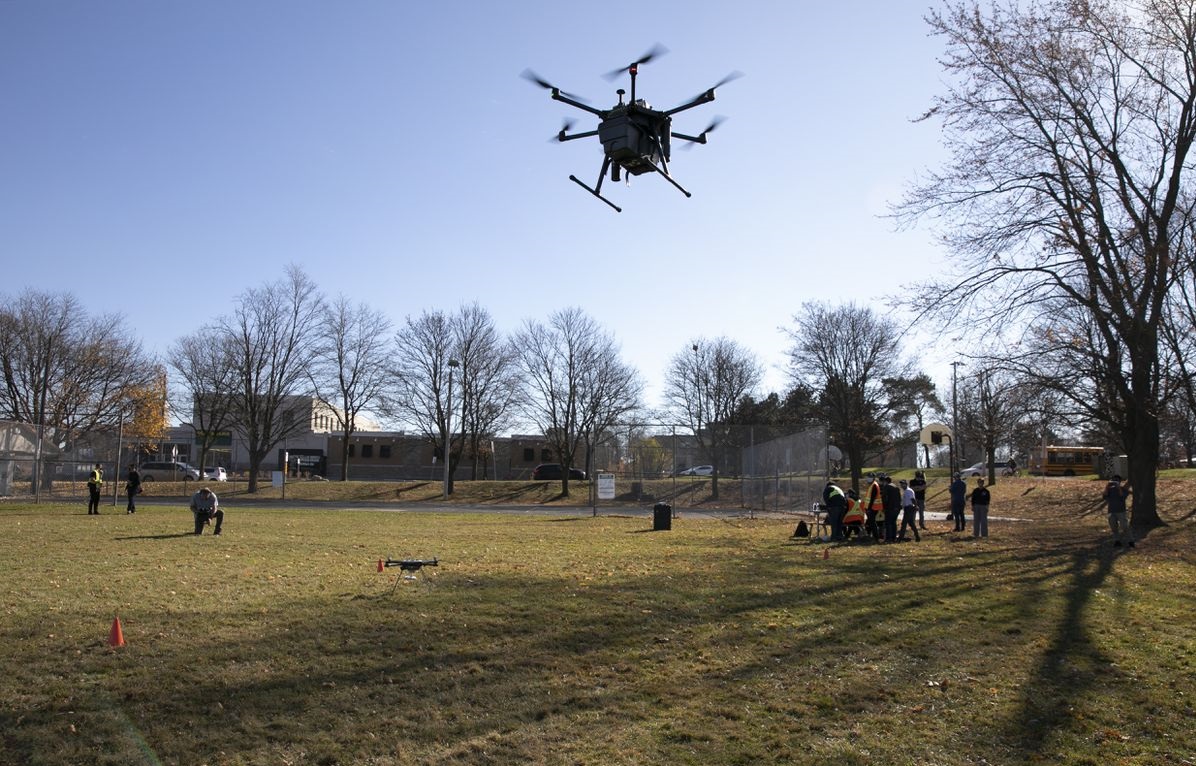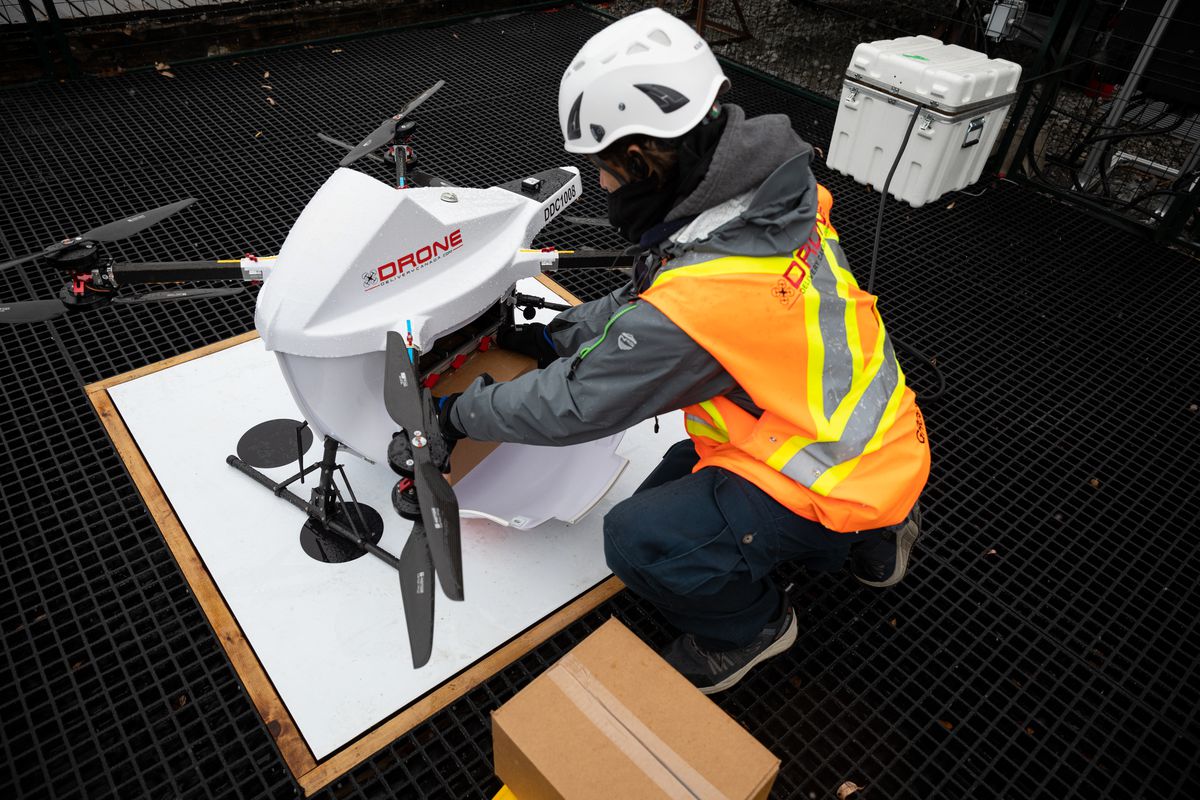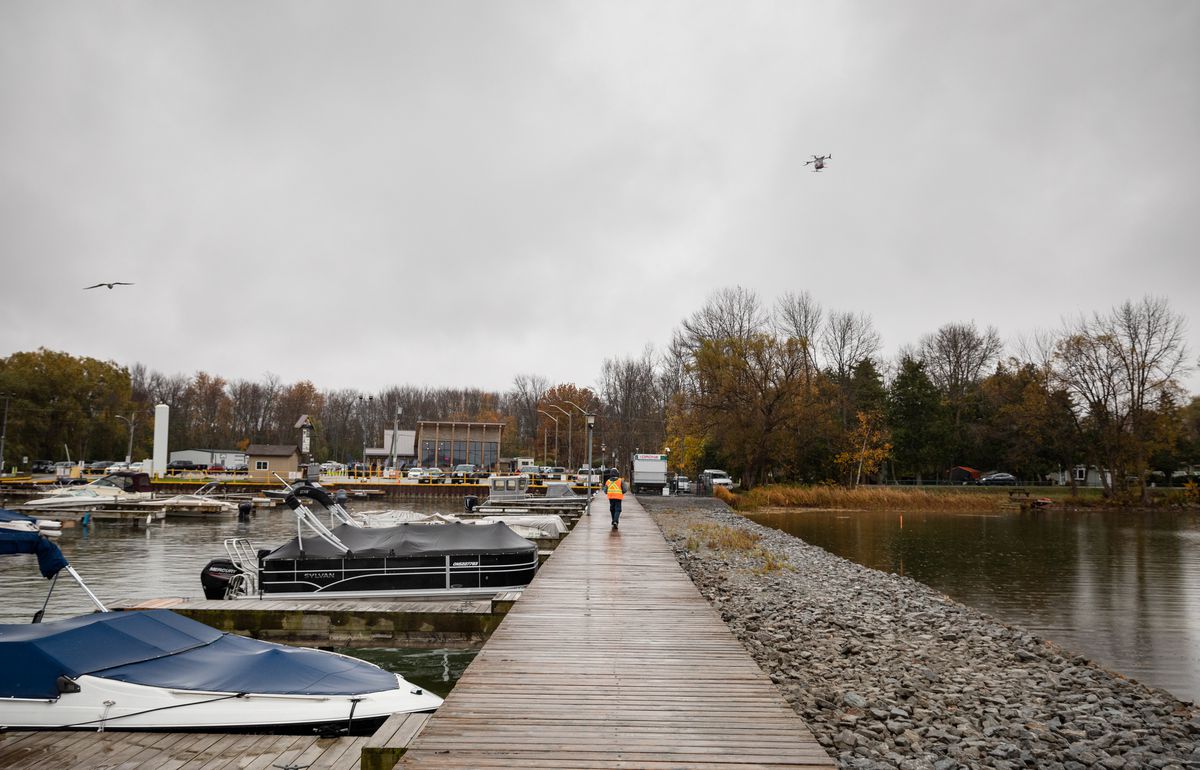As the pandemic makes us more dependent on deliveries, drone makers and real estate developers are finding ways to get people their goods – changes they hope will have lasting effects.
A drone from Ontario startup AirMatrix takes off for a test flight over Kitchener. PATRICK DELL/THE GLOBE AND MAIL
The drone rises quickly off the launch pad, hovers briefly and then whines out over the waters of Lake Simcoe on a mission to deliver masks and hand sanitizer to a First Nations community, and maybe inspire its youth in a new direction.
The belly of the little aircraft is modestly sized – roughly the same as a case of wine – and can carry only about 4.5 kilograms of cargo on each flight. But these trips can reduce reliance on the ferry, a roughly 15-minute ride connecting the mainland and island parts of the community east of Barrie, Ont. And it may prove an important air link in the shoulder seasons, when there’s too much ice for boats but not enough to drive over.
The project also comes as the COVID-19 pandemic sparks an explosion in home delivery, a surge in demand that drone advocates say ultimately could see products carried through the skies.
This possible future has caught the eye of some real estate developers, who are considering how to make it possible for drones to land on the roofs of their buildings.
“We have seven projects that are in various stages of construction and … we’re actually looking at ways to have a landing pad for drones,” said Scott McLellan, senior vice-president at developer Plaza Corp. “The drone drops eight packages up on the roof and sends an e-mail to our concierge and says, delivery on the roof,” he added, painting a hypothetical picture. “The concierge goes up, gets the packages and brings them down to the storage area in the lobby.”
This goal, which drone boosters say could revolutionize cities by reducing delivery-truck traffic, still faces a number of hurdles. It’s also not clear how much could realistically be delivered without overwhelming city skies. But progress is being made toward a future that may see fewer packages being driven around.
In the United States, the FAA gave regulatory approval this summer for Amazon Prime Air, which bills itself as “a future delivery system.”
Wing, operated by Google parent company Alphabet, says it has made 100,000 deliveries in four cities in Finland, the United States and Australia, including a number of “democracy sausages” traditionally sold as a fundraiser at Aussie polling sites. Various pilot projects are operating in China.
There have also been advances in Canada. Montreal General Hospital did test delivery flights last year carrying simulated blood and B.C.-based InDro Robotics earlier this month said it had received regulatory approval for commercial drone delivery flights.

At top, the AirMatrix drone rises above its staging area in Kitchener’s Weber Park. For this test, AirMatrix has laid out a flight plan between four points, bottom left. AirMatrix co-founder Shayaan Haider, middle at bottom right, pilots the drone while product manager Nikita Ramsisaria, left, and hardware engineer Aldo Castro, right, monitor its flight. DEBORAH BAIC/THE GLOBE AND MAIL
In Ontario, a start-up called AirMatrix has plotted aerial routes in Kitchener-Waterloo and recently began flying them. The company says its “highways in the sky” are designed to prevent aerial “chaos” and could offer benefits such as enabling the efficient transportation of organs for transplant surgery, faster emergency response and fewer packages on the roads.
“We map out specific skyways so that we know exactly where we do and don’t want drones to go [between] specific depots,” said Alexandra McCalla, AirMatrix co-founder.
“We’re putting in the infrastructure to make sure [urban delivery is] safe, and it’s going to be kind of a slow progression over time. And then, like with anything, okay it’s everywhere all of a sudden.”
Others in the drone world make the same point: this technology is not in the realm of science fiction.
Michael Zahra, CEO of Drone Delivery Canada, the firm doing flights to Georgina Island First Nation on Lake Simcoe as well as supplying Beausoleil First Nation on Georgian Bay, acknowledged that this is “a nascent industry.” Some companies have little more than a website and an idea. But he argues that his company – which trades on the TSX venture exchange and began commercial operations last year, with the goal of becoming the top global drone delivery firm – is among a number of those making real progress.
“We’re at an inflection point where the industry is, no pun intended, about to take off,” he said. “You’re seeing a lot more news. Again, some smoke and mirrors. Some real, like what we’re doing. You’re seeing a lot more activity and focus, government attention, funding, some pilot projects.”
In recent years, commercial drones have become routine tools for inspecting remote infrastructure and monitoring sensitive sites. Their use has been progressing into more difficult aerial environments. They are edging closer to cities, where there are more obstacles and more congested skies. In the meanwhile, projects in areas such as these First Nations in Ontario remain more common.
To get to the point of widespread and reliable urban drone delivery, a number of issues remain to be worked out. Performance of drones now suffers in extremes of temperature, with cold weather resulting in reduced battery life and heat hampering lift capacity. Drones need a place to land when making a delivery, and a secure way to leave packages for recipients who are not present. Traffic management systems would need to be robust and safe. And complaints about noise pollution and aerial congestion would need to be managed.
Even if all that is accomplished, it remains to be seen whether large-scale use of delivery drones is practical. In a September, 2020, article in the Journal of Air Transport Management, the authors looked at how many drones would be required to transport the 70 per cent of packages that are light enough to be carried this way and are not going to destinations where the volume of deliveries makes an automobile more efficient. By 2035, they calculated, a major city such as Paris would require about 78,000 drone flights an hour.
Another analysis, this one released in April by the consulting firm Roland Berger, looked at how many drones could fly at once over Berlin and concluded that a realistic number could carry only 3.6 per cent of small deliveries.
“In terms of just mass amount of consumer packages being delivered to people’s homes, I would not plan on that being the solution,” said Tray Anderson, head of logistics at the commercial real estate services firm Cushman & Wakefield, who thinks drones are likely to be most useful in rural settings. “I think there’ll be some adoption of drones. I don’t think it’ll be zero. But when you talk about, you know, 80,000, I simply don’t see that happening.”
Already there are hints that drone delivery is best suited to higher-value cargoes. AirMatrix says its flights could include the transport of organs for transplant; Drone Delivery Canada says its vehicles may carry prescriptions, COVID-19 test swabs and other essential medical materials.
And no matter what they carry, there may also be a corollary benefit to the flights. Mr. Zahra hopes his company’s presence in the First Nations will help encourage young people toward STEM careers.
“I mean, it’s visible to them, we’re flying right into the community from the mainland to the island,” he said. “The intent is for us to go into the schools in the future … and have some of our engineers talk to the youth, have some giveaways of small drones and that sort of thing, to really get them excited about something that’s different.”
Drones in depth
Ontario startup AirMatrix sees a future where scores of commercial drones will cross the skies. Here’s an inside look at how they’re creating detailed drone ‘roads’ to manage that traffic in the air. THE GLOBE AND MAIL
OLIVER MOORE, URBAN AFFAIRS REPORTER
GEORGINA ISLAND FIRST NATION
The Globe and Mail, Novemer 14, 2020



